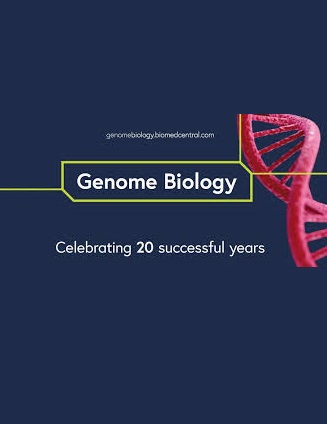SETD2功能丧失独特地使细胞对nsd1定向的H3K36甲基化的表观遗传靶向敏感
IF 10.1
1区 生物学
Q1 BIOTECHNOLOGY & APPLIED MICROBIOLOGY
引用次数: 0
摘要
SETD2是哺乳动物中唯一负责催化组蛋白3赖氨酸36三甲基化(H3K36me3)的表观遗传因子。它在调节细胞过程中的作用,如RNA剪接、DNA修复和假转录起始,是其更广泛的肿瘤抑制功能的基础。SETD2突变促进上皮-间质转化,并且在临床上与不良结果相关,强调了针对这种危险突变开发靶向治疗的治疗需求。我们采用了无偏倚的全基因组合成致死性筛选,鉴定出另一个H3K36me写子NSD1作为setd2突变细胞中的合成致死性修饰子。在小鼠和人类等基因透明细胞肾细胞癌和永生化肾上皮细胞系中证实了这种合成致死相互作用。使用CRISPRi靶向方法去除NSD1可促进setd2突变细胞的丢失,同时DNA损伤和凋亡水平升高。令人惊讶的是,在这些模型中,只有抑制NSD1,而不抑制相关的h3k36 -甲基转移酶,才能促进合成致死。通过NSD1和NSD2分别定位基因组H3K36me2靶向,突出了这些表观遗传书写者的独立功能。此外,作为原理证明,我们通过使用BT5(一种针对NSD1的一流药物抑制剂)重现这种表型,证明了靶向这种合成致死相互作用的治疗可行性。这些发现将全基因组筛选方法与最新的遗传和药理学建模方法统一起来,揭示了一种全新的表观遗传学方法,可以针对癌症中具有挑战性的功能丧失SETD2突变进行个体化治疗。本文章由计算机程序翻译,如有差异,请以英文原文为准。
SETD2 loss-of-function uniquely sensitizes cells to epigenetic targeting of NSD1-directed H3K36 methylation
SETD2 is the sole epigenetic factor responsible for catalyzing histone 3, lysine 36, tri-methylation (H3K36me3) in mammals. Its role in regulating cellular processes such as RNA splicing, DNA repair, and spurious transcription initiation underlies its broader tumor suppressor function. SETD2 mutation promotes the epithelial-mesenchymal transition and is clinically associated with adverse outcomes highlighting a therapeutic need to develop targeted therapies against this dangerous mutation. We employ an unbiased genome-wide synthetic lethal screen, which identifies another H3K36me writer, NSD1, as a synthetic lethal modifier in SETD2-mutant cells. Confirmation of this synthetic lethal interaction is performed in isogenic clear cell renal cell carcinoma and immortalized renal epithelial cell lines, in mouse and human backgrounds. Depletion of NSD1 using a CRISPRi targeting approach promotes the loss of SETD2-mutant cells coincident with elevated levels of DNA damage and apoptosis. Surprisingly, only suppression of NSD1, but not related H3K36-methyltransferases, promotes synthetic lethality in these models. Mapping of genomic H3K36me2 targeting by NSD1 and NSD2 individually highlights the independent functions of these epigenetic writers. Furthermore, as a proof-of-principle, we demonstrate the therapeutic feasibility of targeting this synthetic lethal interaction by recapitulating the phenotype using BT5, a first-in-class pharmacologic inhibitor against NSD1. These findings unify genome-wide screening approaches with the latest genetic and pharmacologic modeling methodologies to reveal an entirely novel epigenetic approach to individualize therapies against a challenging loss-of-function SETD2 mutation in cancer.
求助全文
通过发布文献求助,成功后即可免费获取论文全文。
去求助
来源期刊

Genome Biology
Biochemistry, Genetics and Molecular Biology-Genetics
CiteScore
21.00
自引率
3.30%
发文量
241
审稿时长
2 months
期刊介绍:
Genome Biology stands as a premier platform for exceptional research across all domains of biology and biomedicine, explored through a genomic and post-genomic lens.
With an impressive impact factor of 12.3 (2022),* the journal secures its position as the 3rd-ranked research journal in the Genetics and Heredity category and the 2nd-ranked research journal in the Biotechnology and Applied Microbiology category by Thomson Reuters. Notably, Genome Biology holds the distinction of being the highest-ranked open-access journal in this category.
Our dedicated team of highly trained in-house Editors collaborates closely with our esteemed Editorial Board of international experts, ensuring the journal remains on the forefront of scientific advances and community standards. Regular engagement with researchers at conferences and institute visits underscores our commitment to staying abreast of the latest developments in the field.
 求助内容:
求助内容: 应助结果提醒方式:
应助结果提醒方式:


